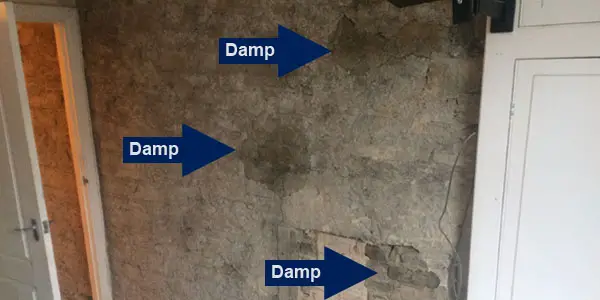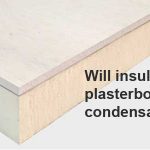The DIY Fix is reader supported. When you buy after clicking a link on our site, we may earn an affiliate commission.

When it comes to adding a high-quality plaster finish, it is hard to find a more simple and effective method than boarding and skimming.
In most cases boards can be fitted floor to ceiling and provide a perfectly flat surface to skim.
Unless you are screwing the boards to timber stud walls, the most common method of fixing boards is dot and dab with a board adhesive. However, in some cases this may not be the best option.
If your walls are damp you should never dot and dab standard plasterboard’s. In most cases the damp will travel through the board adhesive and create damp patches.
The first thing you will need to do is fix the problem that is causing the damp on your walls. Hiding damp issues is not a solution, and if left untreated it is highly likely they will get worse over time.
Even when your damp problem is fixed, it still might not be the best idea to dot and dab. A better solution would be to attach treated timber battens to the walls and screw your boards to the battens.
Something like a treated roofing batten would be a good option for this method
When using battens and then boarding, moisture will not be able to travel through like it would with dot and dab. Board adhesive provides an ideal way for moisture to travel from the wall to the newly plastered surface.
Another advantage of using battens, is you can use foil backed plaster boards. These will add an additional vapour barrier that any moisture will not be able to pass through.
Dot and dab on previously damp walls
If you have a wall that was damp in the past, due to a serious issue such as rising damp or penetrating damp, you may still want to avoid dot and dab.
Even if the problem has been completely fixed, this method could still cause issues.
The problem you may face at this point, is moisture and hygroscopic salts that remain in the wall. Even if you spend time to dry the wall, it is almost guaranteed that some moisture will remain.
Hygroscopic salts can pose another problem. This is because they will absorb water vapour from the surrounding air.
If any of this moisture meets a dab, there is a good chance it will wick through to the surface of your finished plaster.
Due to these potential issues, it is worth spending a small amount of extra time adding battens to fix your boards too.
Dot and Dab on walls suffering with condensation
But what if your damp issues are not penetrating from outside or rising from the ground? The most common form of damp in homes is condensation.
The reason for condensation on a wall is usually that it is a cold surface. This means that the wall acts as a dew point. When warm moist air meets a cold surface, the moisture condenses on the surface.
The effects of condensation will often build up over time, the result can be damp areas and mould growth.
The problem with dot and dab using standard boards on a cold wall, is that the problem will persist after your boards have been skimmed. The only difference is the cold will pass through the dabs, forming damp patches.
If you make this mistake, the cold dabs will often be very noticeable.
Not only will you be able to see the dabs due to the damp patches. But you will be able to physically feel the difference when you touch them. In many cases, they will be noticeably colder than the rest of the wall.
So, what is the solution?
In this instance, you don’t need to completely give up on attaching boards via dot and dab. This is still an option. However, you will need to use different boards.
Insulated boards would solve the problem, but they are considerably more expensive. A standard 2400 x 1200mm insulation board will set you back around £57 if you opt for Kingspan insulation boards.
There may be more affordable options from other brands, but you will need to check with your local builders’ merchant.
Despite the high price, it will warm the surface of the wall and stop condensation forming. Whats more, it will help you to conserve heat and add to the thermal insulation in your home.
You can attach these boards with a dry wall adhesive (dot and dab). However, you also still have the option of adding battens and screwing to the wall.
If £50+ per board is a bit steep, and you are not bothered about adding extra insulation, the next best option is going back to timber battens and foil backed plasterboard.
Even adding a small gab behind plasterboard with foil backed boards should bring the surface temperature up. This is because it will no longer be in contact with the external wall.
Whilst foil back boards won’t add much extra warmth to your property, it should be enough to reduce condensation forming on the surface.
Conclusion
Dot and dab on a damp wall is rarely a good solution. It is highly likely that damp will travel through the dabs and the problem will persist.
In some instances, you can dot and dab with insulation boards. However, you should always solve the cause of damp on internal walls first.
Boards with a vapour barrier should not be used as a way of hiding damp. If the underlying issue is not fixed it will resurface eventually.
When you ignore damp and try to hide the issue, you are only delaying the inevitable repairs that will be required. Not only that, but you are allowing the problem to worsen, and this will just increase the damage it causes and the cost of repairs.


